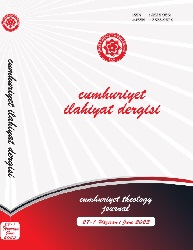منهج التخريج في حل القضايا الفقهية المعاصرة في نماذج فتاوى المجلس الأعلى للشؤون الديني ة
The Method of Takhrîj in Answering Contemporary Fiqh Problems: The Example of The Fatwas of The High Board of Religious Affairs
Author(s): Mustafa Bülent DadaşSubject(s): Islam studies, Health and medicine and law, Sharia Law
Published by: Cumhuriyet Üniversitesi İlahyat Fakültesi
Keywords: Fiḳh; High Council of Religious Affairs; Fatwa; Current Fiḳh Issues; Takhrij in Fiḳh; Commercial Insurance; Organ Transplantation;
Summary/Abstract: In this article, the takhrij method used in the solution of current fiḳh issues that have emerged throughout the history of fiḳh has been described and some sample fatwas given by the High Council of Religious Affairs based on this method have been analysed. Takhrij, as a method in the fiḳh is defined as "to determine the procedural and fiḳh rules of a madhhab imam based on his singular views on which these opinions are based, and to determine the verdict of the issues in which an opinion is not narrated from that imam, according to the reached rules." There 3 types of takhrij, the first is "identifying procedural rules of a madhab imam based on his views on secondary issues", the second type is "determining the verdict of the issues based on principle rules whose verdict is not determined by the imam of the madhhab" and last type is "determining the verdict of another secondary issue in the light of the verdict of an issue whose verdict is determined by the imam of the madhhab". When the history of fiḳh is examined, it is seen that the jurists solved the provisions of the new issues they encountered with the method of takhrij. By using the takhrij method, the jurists contributed to the formation, development and dissemination of the unique methodology of the madhab they belonged to. As it is known, the procedural principles and rules of the fiḳh were developed by the efforts of leading jurists who belonged to the relevant madhhab. In this context, the jurists examined the views of the madhab imams to which they belonged, by inductive method, and brought together the provisions of the singular issues conveyed from them under certain principles and rules. The most important jurists in this field in the Ḥanafī madhab are: Ibn Aban, Bardaī, Karkhī and Māturīdī. Takhrij may differ from one jurist to another, as it is an ijtihad activity. Therefore, the conclusion reached by a jurist who carries out the takhrij activity should not be seen as an opposition to the imam of the madhhab, from whom no clear opinion has been conveyed on the subject. While analysing the subject of takhrij in the fiḳh, the role of Abū Zayd Dabūsī should be specially mentioned. Dabūsī, in his work named Taʼsīs al-naẓar, brought together the singular views conveyed from Ḥanafī madhab imams under the principles he expressed as "essential", taking into account the accumulation of jurists who were his predecessors, and presented the opportunities that the takhrij method provides for jurists with examples. Finally, the takhrij method has been a method that the jurists have taken as a basis in terms of carrying out a consistent ijtihad activity within the madhab in the solution of new issues since the madhabs became settled, and this situation lasted until the beginning of the 20th century. In the following period, the decline in the number of jurists with sectarian background, the spread of some movements that adopt direct reference to the Qur'ân and the Sunnah, and the emergence of complex current fiḳh problems where there is no view suitable for interpretation within the madhab accumulation, led to the abandonment of the takhrij as a method to a large extent. However, today it is observed that this method is used in both individual and collective ijtihad activities. One of the institutions declaring that it cares about the knowledge of fiḳh and makes use of this knowledge to the extent possible in solving current fiḳh issues is the Supreme Council of Religious Affairs. The Council is one of the important institutions of the Islamic world in terms of its efforts to solve current legal issues, its contributions to the unity of fatwa and being a continuation of the Meşîhat-ı İslamiyye. Issues on which the Board gave a fatwa can be evaluated in two categories: those that were resolved by the old jurists and those that any clear opinion is not narrated from the old jurists. The Board generally issues fatwas according to the Ḥanafī Madhab on matters included in the first group, and for the second group of issues The Council cites the views of other madhabs if needed makes a choice among them. For the issues such as surrogacy, test-tube baby (IVF), organ transplantation etc. If it finds an opinion that will be a basis in the fiḳh acquis, it makes use of the method of takhrij. This study aims to reveal the possibilities provided by this method by analysing some current issues that the Board has resolved by making use of the takhrij method. In this context, firstly, the High Council of Religious Affairs has been briefly introduced, and then the definition of takhrij will be made and its types, history, development of fiḳh and its role in the solution of current fiḳh issues has been explained. Finally, the fetwas issud by High Council of Religious Affairs by applying the method of tahrîc or by making use of this method; on commercial insurance, organ transplantation, gold-based lease certificate and the effect of injection/vaccine on fasting will be analysed. In the light of these exemplary fatwas, the importance of the takhrij method for contemporary jurists has been tried to be showed in terms of both maintaining the consistency of fiḳh and its contribution to the development of fiḳh, as it was in the past.
Journal: Cumhuriyet İlahiyat Dergisi
- Issue Year: 27/2023
- Issue No: 1
- Page Range: 90-106
- Page Count: 17
- Language: Arabic

